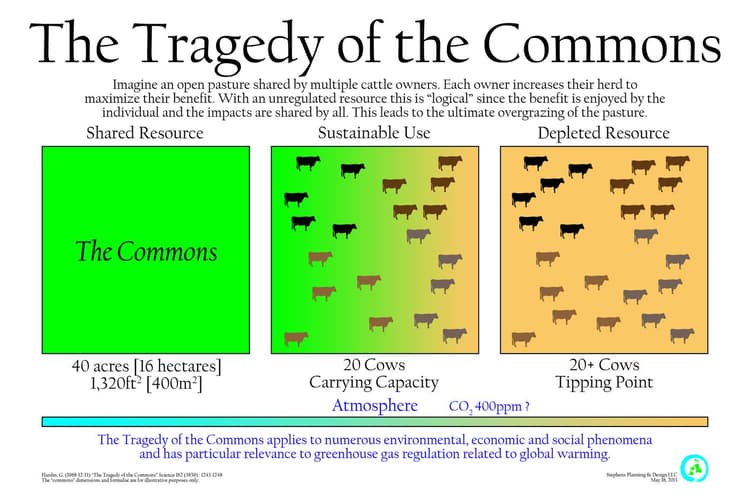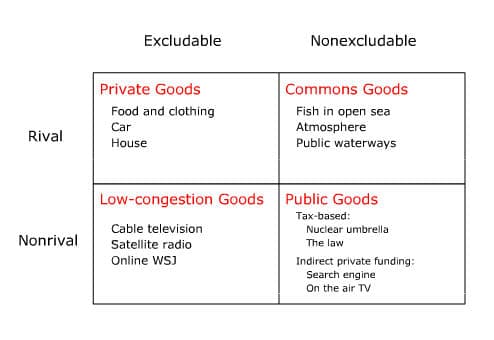Public and Private Goods
Nancy Hill
8 min read
Listen to this study note
Study Guide Overview
This AP Microeconomics study guide covers public goods and market failures. Key topics include: defining public goods and market failures, the free-rider problem, characteristics of public goods (non-excludability and non-rivalry), commons goods, low-congestion goods, and determining the optimal quantity of public goods using MSB and MSC. The guide also includes practice questions and exam tips.
#AP Microeconomics Study Guide: Public Goods & Market Failures 🚀
Hey there, future AP Micro wiz! Let's break down public goods and market failures. This guide is designed to be your go-to resource, especially when you're cramming the night before the exam. We'll make sure everything clicks, and you'll feel totally ready to ace it!
#1. Introduction to Public Goods and Market Failures
This section is a must-know! Public goods and market failures are core concepts in microeconomics and frequently tested.
- Public Goods: These are goods provided by the government because the free market fails to produce them efficiently. Think of it as the government stepping in when the private sector can't make it work.
- Market Failure: This happens when the free market doesn't allocate resources efficiently. Public goods are a classic example of this, because they are not profitable for private firms to produce.
- Private Sector: The free market where consumers and firms make all the economic decisions.
- Public Sector: The government-run market for public goods and services.
#1.1 The Free-Rider Problem
The free-rider problem is a central concept for understanding why public goods are necessary.
- Definition: People consume more than their fair share of a public good or pay less than their fair share of its cost.
- Why it Happens: Public goods are non-excludable, meaning you can't prevent someone from using them, even if they don't pay.
- The Paradox: If there are no free-riders, it means the good is not truly public.
- Consequence: Inefficient distribution of goods and services. The market fails to allocate resources properly because there's no incentive to pay for something you can get for free.
- Government Solutions:
- Taxation: Tax everyone to fund public goods.
- Punishment: Find ways to punish free-riders (but this can make the good non-public).

#2. Characteristics of Public Goods
Remember these two criteria: non-excludable and non-rival. They are key to identifying public goods.
For a good to be considered a public good, it must meet two criteria:
#2.1 Non-Exclusion
- Definition: You can't prevent anyone from using the good, even if they don't pay.
- Examples:
- Public Park: Everyone can enter, regardless of payment.
- Highway: You can't stop someone from driving on it.
- Contrast:
- iPhone: Apple can refuse to sell to someone.
- Restaurant: They can enforce "no shirt, no shoes, no service."
#2.2 Shared Consumption / Non-Rivalry
- Definition: One person's use of the good doesn't reduce its availability for others.
- Example:
- National Defense: Your protection doesn't diminish someone else's protection.
- Street Lighting: One person using the light doesn't reduce its benefit for others.
#2.3 Public vs. Private Goods
- Public Goods: Must meet both non-exclusion and non-rivalry criteria.
- Private Goods: Have neither characteristic.
- Mixed Goods: Satisfy one of the criteria, and can be provided by either the public or private sector.

#3. Low-Congestion and Commons Goods
Understanding the differences between these types of goods can help you tackle complex FRQs.
When goods meet only one of the criteria for public goods, they fall into these categories:
#3.1 Commons Goods
- Definition: Non-excludable but rival.
- Example:
- Fish in the Open Sea: Anyone can fish, but one person catching a fish means one less for others.
- Tragedy of the Commons: Overconsumption due to self-interest, leading to depletion of the resource.
- Key Difference: Unlike free-riders (who don't contribute to cost), tragedy of commons deals with overusing a rival resource.

#3.2 Low-Congestion Goods (Club Goods)
- Definition: Excludable but non-rival.
- Example:
- Cable Television: You can be excluded if you don't pay, but your watching doesn't prevent others from watching.
- Underutilization: Often underused due to their excludable nature.
- Congestion: Can become inaccessible if overused.
#3.3 Four Types of Goods
Use this table to quickly classify any good:
- Public Goods: Non-excludable and non-rival
- Private Goods: Excludable and rival
- Commons Goods: Non-excludable and rival
- Club Goods: Excludable and non-rival

#4. Optimal Quantity of Public Goods
Students often mix up marginal social benefit and marginal social cost. Double-check which is which!
- Optimal Production: The government should produce public goods where Marginal Social Benefit (MSB) = Marginal Social Cost (MSC).
- MSB: The additional benefit to society from one more unit of the public good.
- MSC: The additional cost to society from one more unit of the public good.
#4.1 Example: Parks
Let's use the example from the notes:

- Optimal Number of Parks: 6, because at this point MSB (300).
#5. Final Exam Focus
Focus on the free-rider problem, the characteristics of public goods, and how to determine the optimal quantity. These are frequently tested.
- High-Priority Topics:
- Free-rider problem and its implications
- Non-excludability and non-rivalry of public goods
- Tragedy of the commons and its consequences
- Marginal social benefit and marginal social cost analysis
- Common Question Types:
- Multiple-choice questions testing definitions and classifications of goods.
- FRQs requiring you to analyze scenarios involving public goods and market failures.
- FRQs requiring you to calculate optimal quantity of public goods.
- Time Management:
- Quickly identify key terms in the questions.
- Use diagrams to help you solve problems.
- Don't spend too long on any single question.
- Common Pitfalls:
- Confusing non-excludability with non-rivalry.
- Misidentifying types of goods.
- Not understanding the concept of marginal analysis.
- Strategies:
- Read the questions carefully.
- Use diagrams to help you understand the concepts.
- Practice, practice, practice!
#6. Practice Questions
Practice Question
#Multiple Choice Questions
-
Which of the following is the best example of a public good? (A) A slice of pizza (B) A concert ticket (C) National defense (D) A private tutoring session (E) A new car
-
The free-rider problem occurs when: (A) A good is rival but non-excludable (B) A good is excludable but non-rival (C) Individuals consume more than their fair share of a public good (D) Firms produce too much of a good (E) A market is perfectly competitive
-
Which of the following is a characteristic of a common good? (A) Non-rival and excludable (B) Rival and excludable (C) Non-rival and non-excludable (D) Rival and non-excludable (E) None of the above
#Free Response Question
Assume that a city is considering building a new public park. The following table shows the marginal social benefit (MSB) and marginal social cost (MSC) of building different numbers of parks.
| Number of Parks | Marginal Social Benefit (MSB) | Marginal Social Cost (MSC) |
|---|---|---|
| 1 | 100 | |
| 2 | 150 | |
| 3 | 200 | |
| 4 | 250 | |
| 5 | 300 | |
| 6 | 350 |
(a) What is the optimal number of parks the city should build? Explain your reasoning. (b) Explain why the free market would not provide the optimal number of parks. (c) Suppose the city decides to build one more park than the optimal number. What is the marginal social cost of building this additional park? What is the marginal social benefit?
#Scoring Guide
(a) Optimal number of parks (2 points):
- 1 point for stating the optimal number of parks is 5. * 1 point for explaining that the optimal number is where MSB equals MSC.
(b) Free market failure (2 points):
- 1 point for stating that the free market would not provide the optimal number of parks due to the free-rider problem.
- 1 point for explaining that individuals can benefit from the park without paying, so private firms have no incentive to provide it.
(c) Marginal Social Cost and Benefit (2 points):
- 1 point for stating that the marginal social cost of the 6th park is 250.
You've got this! Remember, understanding the core concepts and practicing with different question types will get you to your goal. Good luck on your AP Microeconomics exam! 🍀
Continue your learning journey

How are we doing?
Give us your feedback and let us know how we can improve





